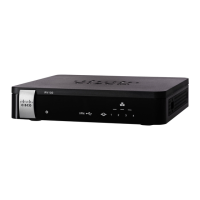Configuring VPN
Configuring Basic Site-to-Site IPsec VPN
Cisco RV130/RV130W Wireless Multifunction VPN Router Administration Guide 100
6
• Remote Endpoint—Choose if the router to which your device will connect
will be identified by its IP address or by a fully qualified domain name. For
example, an IP address such as 192.168.1.1 or a fully qualified domain name
such as cisco.com.
• Remote WAN (Internet) IP Address—Enter the public IP address or domain
name of the remote endpoint.
• Local WAN (Internet) IP Address—Enter the public IP address or domain
name of your device.
STEP 5 In the Secure Connection Remote Accessibility fields, enter the following
information:
• Remote LAN (Local Network) IP Address—The private network (LAN)
address of the remote endpoint. This is the IP address of the internal network
at the remote site.
• Remote LAN Subnet Mask—The private network (LAN) subnet mask of the
remote endpoint.
• Local LAN (Local Network) IP Address—The private network (LAN)
address of the local network. This is the IP address of the internal network
on the device.
• Local LAN (Local Network) Subnet Mask—The private network (LAN)
subnet mask of the local network.
Note: The remote WAN and remote LAN IP addresses cannot exist on the same
subnet. For example, a remote LAN IP address of 192.168.1.100 and a local LAN IP
address of 192.168.1.115 causes a conflict when traffic is routed over the VPN. The
third octet must be different so that the IP addresses are on different subnets. For
example, a remote LAN IP address of 192.168.1.100 and a local LAN IP address of
192.168.2.100 is acceptable.
STEP 6 Click Save.
Viewing Default Values
Click View Default Settings to view the default values used in the basic VPN
settings. These values are proposed by the VPN consortium and assume that you
are using a pre-shared key, or password that is known to both your device and the
remote endpoint.

